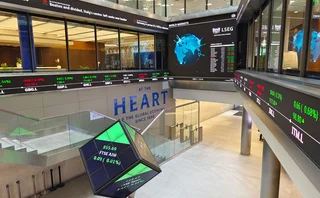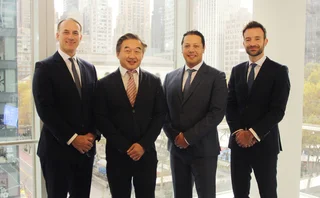
Asset manager of the year, systematic investing: BlackRock
Risk Awards 2018: Giant manager has in-built advantages, but is also breaking new ground

Asset managers such as BlackRock – with big, sophisticated trading operations and consequent pricing clout – have an obvious advantage in factor investing. After all, part of the appeal to asset owners is the promise of returns in line with active managers but at a fraction of the cost.
“For every basis point we save it pays the annual pension benefit for 400 beneficiaries,” says a pension fund manager. “We don’t see factor investing as a magic potion. It’s a fee arbitrage opportunity.”
The firm’s $177 billion in smart beta assets is testament to the effect. But recently BlackRock has also been using its heft in a different way – drawing on the information it gathers from global markets to offer more complex products.
Andrew Ang, a former Columbia Business School professor, who joined BlackRock in 2015 to lead the firm’s factor strategies team, describes it as “the frontier” in factor investing – funds that harvest simple, well-known risk premia such as momentum or carry, but across multiple asset classes.
In this area, Ang’s team runs a $13 billion risk-parity strategy – Market Advantage – based on balancing macro factors across equities, bonds and commodities, and a fast-growing $3 billion multi-asset multi-factor strategy – Style Advantage – launched in late 2015.
Last year, the firm launched its first exchange-traded funds applying factor investing in credit, a key achievement given that efforts to extend factor investing to corporate bonds have been slowed by liquidity concerns. These are also the first ETFs BlackRock has launched referencing an in-house rather than third-party index.
“We have just begun to scratch the surface for factors in asset classes [beyond equities],” Ang says.
The factor investing team looks to leverage BlackRock’s pool of pricing and liquidity data, which sees the firm generate transaction cost estimates for more than 50,000 securities daily in its Aladdin trading and risk management system.
Every equity that trades, every fixed-income instrument that trades, there is a price for it in Aladdin, and we have an understanding of how we can access those markets
Sara Shores, BlackRock
The Style Advantage fund, for example, invests in 2,800 global equities, and across 23 equity markets, 24 currency markets and 16 bond markets, says Sara Shores, head of investment strategy in the factor-based strategy group – only possible because of the breadth of the firm’s trading data.
That same information is equally critical in managing the corporate bond portfolios of BlackRock’s two credit ETFs, she says. The portfolio optimisation for these ETFs – which screen bonds based on their probability of default, then tilt the portfolios towards value – incorporates estimates of transaction costs.
“Every trade we do is archived and analysed,” Shores says. “Every equity that trades, every fixed-income instrument that trades, there is a price for it in Aladdin, and we have an understanding of how we can access those markets.”
History
BlackRock likes to stress its 30-year history in quant investing – Barclays Global Investors, which BlackRock bought in 2009, launched its systematic Alpha Tilts fund in 1985 – though the firm only brought together a formal factor investing team in 2013. Ang says knitting together the firm’s previously separate efforts has been a “major achievement”.
The firm’s other factor investing products include funds that rebalance exposures from riskier to more defensive factors as customers approach retirement, and a Total Factor mutual fund in the US, combining the risk parity and risk premia strategies.
BlackRock plans to launch a Ucits version of the Total Factor strategy next year, and is working on developing long and short factor ETFs as a tool for clients to adjust portfolio exposures as an alternative to using total return swaps from banks.
Meanwhile, Ang and his team have been energetic producers of research – often on controversial topics such as factor capacity and the potential for factor timing.
BlackRock launched factor rotation model portfolios in September 2016, and publishes monthly factor outlook guidance, for example. Total assets under management based on these models is about $1 billion.
Despite these client outreach efforts, though, explaining factor investing to clients can still be tough, says Shores. “If you are a traditional Morningstar Style Box manager, us talking to you about quality or momentum does not fit into that paradigm,” she says. “If you do asset allocation thinking about large-cap equities and global bonds, us talking to you about economic growth and rates does not fit into that paradigm.”

We have just begun to scratch the surface for factors in asset classes [beyond equities]
Andrew Ang, BlackRock
To help bridge the gap in understanding, the team has built a tool – Aladdin Factor Workbench – to show asset allocations in terms of factor exposures and vice versa.
The tool lets investors choose the exposures they want to target and determine how to rebalance their portfolio accordingly, taking into account constraints such as liquidity requirements.
“In the past, you could see how you looked in the factor space and your portfolio might not be that diversified. But it was like being told you were ugly and there was no cure,” says one client. “You’d think: that’s great, but how do I go from factors back to assets?”
Behind a simple, intuitive front end, the mathematical modelling is complex. “Fifteen assets projected onto six factors – that is mathematically possible. Six factors projected onto 50 possible assets is not a unique solution,” the client says.
Twenty-five clients are using the tool now, with plans to make it available to all Aladdin users and other important clients in the first half of 2018. The workbench covers macro factors at present, with style factors to be added next year.
Crowding fears
These advances aside, worries persist in the industry about so-called factor crowding – the possible fallout from a forced reversal in systematic strategies. Some, meanwhile, argue that transaction costs in popular strategies already outweigh the premia they aim to capture.
BlackRock takes the view the capacity of factor investing is far greater than critics assert.
But should fears about forced unwinds in systematic strategies prove true, clients say BlackRock’s size once again gives the firm an advantage over rivals – any troubles would be largely invisible to the market.
“The risk of anyone shooting against you is minimal,” says one. “But with BlackRock, if someone looks at their 13Fs, or whatever, they’ll just have no clue what any one fund is doing.”
Only users who have a paid subscription or are part of a corporate subscription are able to print or copy content.
To access these options, along with all other subscription benefits, please contact info@risk.net or view our subscription options here: http://subscriptions.risk.net/subscribe
You are currently unable to print this content. Please contact info@risk.net to find out more.
You are currently unable to copy this content. Please contact info@risk.net to find out more.
Copyright Infopro Digital Limited. All rights reserved.
As outlined in our terms and conditions, https://www.infopro-digital.com/terms-and-conditions/subscriptions/ (point 2.4), printing is limited to a single copy.
If you would like to purchase additional rights please email info@risk.net
Copyright Infopro Digital Limited. All rights reserved.
You may share this content using our article tools. As outlined in our terms and conditions, https://www.infopro-digital.com/terms-and-conditions/subscriptions/ (clause 2.4), an Authorised User may only make one copy of the materials for their own personal use. You must also comply with the restrictions in clause 2.5.
If you would like to purchase additional rights please email info@risk.net
More on Awards
Clearing house of the year: LCH
Risk Awards 2025: LCH outshines rivals in its commitment to innovation and co-operation with clearing members
Best use of machine learning/AI: CompatibL
CompatibL’s groundbreaking use of LLMs for automated trade entry earned the Best use of machine learning/AI award at the 2025 Risk Markets Technology Awards, redefining speed and reliability in what-if analytics
Markets Technology Awards 2025 winners’ review
Vendors jockeying for position in this year’s MTAs, as banks and regulators take aim at counterparty blind spots
Equity derivatives house of the year: Bank of America
Risk Awards 2025: Bank gains plaudits – and profits – with enhanced product range, including new variants of short-vol structures and equity dispersion
Law firm of the year: Linklaters
Risk Awards 2025: Law firm’s work helped buttress markets for credit derivatives, clearing and digital assets
Derivatives house of the year: UBS
Risk Awards 2025: Mega-merger expected to add $1 billion to markets revenues, via 30 integration projects
Interest rate derivatives house of the year: JP Morgan
Risk Awards 2025: Steepener hedges and Spire novations helped clients navigate shifting rates regime
Currency derivatives house of the year: UBS
Risk Awards 2025: Access to wealth management client base helped Swiss bank to recycle volatility and provide accurate pricing for a range of FX structures







